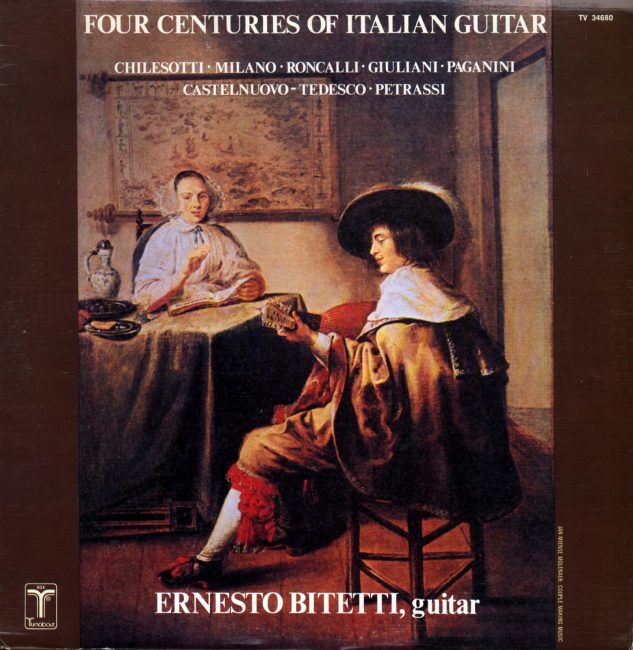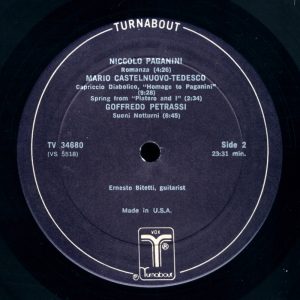
Turnabout TV 34680 – Four Centuries of Italian Guitar
Four Centuries of Italian Guitar
Ernesto Bitetti
Turnabout VOX – TV 34680
01 Chilesotti – Six Pieces for Lute
02 Milano – Ricercare 16 & 28
03 Roncalli – Prelude, Sarabande and Gigue
04 Giuliani – Grand Overture Op. 61
05 Paganini – Romanza
06 Castelnuovo-Tedesco – Capriccio Diabolica ‘Homage to Paganini’
07 Castelnuovo-Tedesco – Spring [from Platero and I]
08 Petrassi – Suoni Notturni
from the LP cover:
The purpose of this disc is to render a tribute to those Italian musicians who devoted a large part of their lives to the composition and execution of works designed for the lute and the guitar.
From this array of talent—which covers four centuries and runs the gamut from the Renaissance lute to the con temporary guitar—I have selected those composers whom I consider to be the most representative of each period. For reasons of space it is impossible to include others who may be no less important.
The lute achieved its greatest success it Italy during the 16th century; a success that was to be repeated half a century later in France and England. In Italy, many composers emerged during that period, among them Francesco da Milano, Vincenzo Galilei, Cesare Negri and Simone de Molinaro. The oldest treatise on this instrument is titled “Intabulatura de Lauto” [sic; this should be “liuto”; title could be translated as “Soundboard Dynamics of the Lute”], and was published in 1508 by Ottaviano de Petrucci. We learn from it that the lute had six strings, its finger board was divided by seven frets, and that it did not have a fixed tonal range, since its strings were plucked with the fingers rather than with a plectrum as had been the previous custom.
The pieces composed for the lute, both sacred and profane, were polyphonic works, some being transcribed while others were original compositions, and the most popular ones were those of a rhythmic nature which originated from the dances of the period.
Oscar Chilesotti (1848-1916), an Italian musicologist, compiled and transcribed into modern musical notation a large number of pieces by different composers, from which are drawn the “Six Pieces” (Seis piczas) featured on the first band of the disc. Four of these pieces arc anonymous, and of the remaining two, one was composed by Cesare Negri and the other by Vincenzo Galilei (the father of the famous astrologer), whose theoretical and practical treatise. “Fronimo,” earned him the right to be considered among the foremost composers of his generation, along with Fran cesco da Milano.
In 1536, Francesco da Milano (b. ca. 1490?), a musician at the court of Mantua (1510) and at that of Ippolito de Medici (1530), published a treatise whose principal works consisted of fantasias [a free-form improvisational style of composition] and ricercares [a contrapuntal composition analogous to the motet in the 16th century, and evolving into an elaborate fugue by the 18th century]. His pieces reveal a depth of thought and feeling that arc unequaled in his period. His entire body of work has been compiled and adapted by Ruggero Chiesa.
If Italian lute music can be said to have had its high point in the 16th century, it certainly began to decline around the beginning of the 17th and, in spite of the prevalence of good composers, the lute was ultimately displaced by the harpsichord, an instrument that was perhaps more precise and brilliant.
Meanwhile, the Spanish guitar, which in the 16th century was a predominantly popular instrument overshadowed by its sister instrument, the viola, then preferred by courtly so ciety, enjoyed a rebirth in 1586 thanks to a Catalonian doc tor, Juan Carlos Amat. whose instructional method, “Spanish Guitar and Bandola, in Two Styles, for Castilian and Catalonian Guitars” (Guitarra espafiola y vandola en dos mancras de guitarras castellana y catalana), opened up new horizons for the Spanish and Italian guitarists who emerged in mid-17th century.
Equally as eminent as Giovanni Battista Granata and Fos- carini was Ludovico, Count of Roncalli, who in 1692 com posed his “Harmonic Capriccios on the Spanish Guitar” (Caprici Armonici sopra la Chitarra Spagnola), pieces grouped in suites, from which I have included “Prelude, Sara band and Jig,” which despite their simple style are neverthe less of undoubted and genuine musical value, free of all popular motifs.
In the latter third of the 18th century the guitar’s ascendancy suffered a decline, to the point where it was almost for gotten. Then, near the end of the century, a group of Spanish amateurs, under the leadership of Father Basilio (Friar Migucr Garcia, inventor of the six-stringed guitar), rescued their national instrument from oblivion by encouraging young guitarists to learn to play the instrument through the use of new musical techniques. In this way they ushered in a period of unrivaled splendor throughout Europe, whose foremost figures were the Spaniards Fernando Sor and Dionisio Aguado, backed up by a raft of Italians that included Federico Moretti. Fernando Carulli, Mateo Carcassi and Luigi Legnani. all of them highly regarded both as teachers and concert per
formers, as well as Mauro Giuliani (1781-1829), who was perhaps the most representative Italian composer and guitar ist of the first half of the 19th century.
Giuliani embarked on a triumphal tour of Europe and Britain, where his fame reached such proportions that his English admirers founded a magazine titled “The Guilianiard.” He became a friend of Beethoven, Haydn, Diabclli and Schubert, and formed a trio with the violinist Mayscdcr and pianist Johann Hummel, who was later replaced by Ignaz Moschcles. Giuliani also composed the first concerto for guitar and orchestra. Opus 30, which was played for the first time on April 8, 1808, in Vienna, where he was then living. Later, he was to compose three more such works in addition to many pieces for the guitar alone, among which one of the best-known is his Grand Overture, Opus 61. This work consists of a slow introduction in the minor key, followed by a sonata movement with a lengthy development section in the major key. His form is classical, his spirit romantic, and his technique that of a virtuoso.
Niccolo Paganini (1782-1840) also took part in this resurgence of the guitar. As a child he studied the mandolin with his father, and later discovered the guitar at Parma in 1795, through his violin teacher, Alessandro Rolle, who used the former instrument to accompany his students. From then on, Paganini devoted many hours of study to the guitar which, in his own words, “stimulates my fantasies when I’m composing and supplies me with harmonies which I can’t obtain from the violin.”
The majority of Paganini’s compositions for the guitar are duets, trios and quartets, but his Grand Sonata for Guitar and Violin is one of his works in which the guitar has the major role and the violin is relegated to that of accompanist. It is from this sonata that I have selected the Romanza included on this disc. It is a lyrical, expressive and sentimental piece, the antithesis of the energetic and percussive Paganini everyone knows.
In mid-19th century the guitar again suffered a decline, only to re-emerge definitively through the efforts of Francisco Tarrega (1854-1909), who initiated a period of con stant evolution right down to the present day, in which the guitar enjoys a prominent place in the world of concert music.
Many famous composers have written music for the guitar, and one of the most important and prolific among them was Mario Castelnuovo-Tedesco (1895-1968). His Capriccio Diabdlico (“An Homage to Paganini’’) was composed in 1935 and bears his characteristic style, with the expressive me lodic line and general virtuosity evoking the image of Paga nini, with reminiscences of Paganinian themes, and ending with the Genoese composer’s popular “Campanella.”
In his Platero y Yo, 28 musical evocations based on the famous book by Juan R. Jimenez, Castelnuovo-Tedesco brought great freshness and simplicity to this tender and universal work of art.
“Primavera,” dated June 16, I960, evokes the awakening of birds, whose warblings gladden and brighten the day as if “they were in a great honeycomb of light inside an im mense, warm and glowing rose.”
I end this review with Goffredo Petrassi (born in 1904), the world-famous Italian composer, of whose vast general work there is no need to comment. His Suoni Notturni (“Nocturnal Sounds”) (1959), comprises a series of tonal and environmental discoveries that give the work an original quality of shadowed mystery.
ERNESTO BITETTI
(Translation from the original Spanish by Marc Rangel)




One thought on “Turnabout TV 34680 – Four Centuries of Italian Guitar”
http://bit.ly/2eBlUsl
pw: basicrep